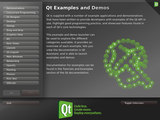
 |
Home · All Classes · All Functions · Overviews |
[Next: Tutorials]
We assume that you already know C++ and will be using it for Qt development. See the Qt website for more information about using other programming languages with Qt.
If you want to program purely in C++, designing your interfaces in code without the aid of any design tools, take a look at the Tutorials. These are designed to get you into Qt programming, with an emphasis on working code rather than being a tour of features.
If you want to design your user interfaces using a design tool, then read at least the first few chapters of the Qt Designer manual.
By now you'll have produced some small working applications and have a broad feel for Qt programming. You could start work on your own projects straight away, but we recommend reading a couple of key overviews to deepen your understanding of Qt: Qt Object Model and Signals and Slots.

At this point, we recommend looking at the overviews and reading those that are relevant to your projects. You may also find it useful to browse the source code of the examples that have things in common with your projects. You can also read Qt's source code since this is supplied.
If you run the Examples and Demos Launcher, you'll see many of Qt's widgets in action.
The Qt Widget Gallery also provides overviews of selected Qt widgets in each of the styles used on various supported platforms.
Qt comes with extensive documentation, with hypertext cross-references throughout, so you can easily click your way to whatever interests you. The part of the documentation that you'll probably use the most is the API Reference. Each link provides a different way of navigating the API Reference; try them all to see which work best for you. You might also like to try Qt Assistant: this tool is supplied with Qt and provides access to the entire Qt API, and it provides a full text search facility.
There are also a growing number of books about Qt programming. We recommend the official Qt book, C++ GUI Programming with Qt 4, Second Edition (ISBN 0-13-235416-0). This book provides comprehensive coverage of Qt programming all the way from "Hello Qt" to advanced features such as multithreading, 2D and 3D graphics, networking, item view classes, and XML. (The first edition, which is based on Qt 4.1, is available online.)
See Books about Qt Programming for a complete list of Qt books, including translations to various languages.
Another valuable source of example code and explanations of Qt features is the archive of articles from Qt Quarterly, a quarterly newsletter for users of Qt.
For documentation on specific Qt modules and other guides, refer to All Overviews and HOWTOs.
Qt has an active and helpful user community who communicate using the qt-interest mailing list, the Qt Centre Web site, and a number of other community Web sites and Weblogs. In addition, many Qt developers are active members of the KDE community.
Good luck, and have fun!
[Next: Tutorials]
| Copyright © 2009 Nokia Corporation and/or its subsidiary(-ies) | Trademarks | Qt 4.6.0 |